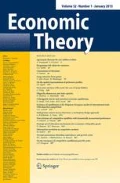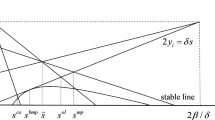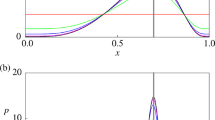Abstract
Many economic problems can be formulated as dynamic games in which strategically interacting agents choose actions that determine the current and future levels of a single capital stock. We study necessary as well as sufficient conditions that allow us to characterise Markov perfect Nash equilibria for these games. These conditions can be translated into an auxiliary system of ordinary differential equations that helps us to explore stability, continuity and differentiability of these equilibria. The techniques are used to derive detailed properties of Markov perfect Nash equilibria for several games including voluntary investment in a public capital stock, the inter-temporal consumption of a reproductive asset and the pollution of a shallow lake.






Similar content being viewed by others
Notes
For a general introduction to the theory of differential games, we refer the reader to Dockner et al. (2000).
Pre-commitment strategies that are set as time functions only are also referred to as open-loop strategies and the corresponding dynamic game as an open-loop game.
A differential equation is called quasi-linear if it is linear in the highest derivatives of the unknown function.
Kossioris et al. (2008) apply the shadow price system approach to an environmental economics problem.
Also called Hamilton, pre-Hamilton or unmaximised Hamilton function.
References
Akao, K.-I.: Tax schemes in a class of differential games. Econ. Theory 35, 155–174 (2008). doi:10.1007/s00199-007-0232-9
Benchekroun, H.: Unilateral production restrictions in a dynamic duopoly. J. Econ. Theory 111, 214–239 (2003)
Benhabib, J., Radner, R.: The joint exploitation of a productive asset: A game theoretic approach. Econ. Theory 2, 155–190 (1992). doi:10.1007/BF01211438
Becker, R.A., Dubey, R.S., Mitra, T.: On Ramsey equilibrium: Capital ownership pattern and inefficiency. Econ. Theory doi:10.1007/s00199-013-0767-x
Brock, W.A., Dechert, W.D.: The polluted ecosystem game. Indian Growth Dev. Rev. 1, 7–31 (2008)
Brock, W., Starrett, D.: Nonconvexities in ecological management problems. Environ. Resource Econ. 26, 575–624 (2003)
Case, J.: Economics and the Competitive Process. New York University Press, New York (1979)
Clemhout, S., Wan, H.: Differential games—Economic applications. In: Aumann, R., Hart, S. (eds.) Handbook of Game Theory, pp. 801–825. North-Holland, Amsterdam (1994)
Crandall, M., Lions, P.-L.: Viscosity solutions of Hamilton–Jacobi equations. Trans. Am. Math. Soc. 277, 1–42 (1983)
Dockner, E., Long, N.V.: International pollution control: Cooperative versus non-cooperative strategies. J. Environ. Econ. Manag. 24, 13–29 (1994)
Dockner, E., Long, N.V., Jørgensen, S., Sorger, G.: Differential Games in Economics and Management Science. Cambridge University Press, Cambridge (2000)
Dockner, E., Long, N.V., Sorger, G.: Analysis of Nash equilibria in a class of capital accumulation games. J. Econ. Dyn. Control 20, 1209–1235 (1996)
Dockner, E., Sorger, G.: Existence and properties of equilibria for a dynamic game on productivity assets. J. Econ. Theory 71, 209–227 (1996)
Dutta, P., Radner, R.: Capital growth in a global warming model: Will China and India sign a climate treaty? Econ. Theory 49, 411–443 (2012). doi:10.1007/s00199-010-0590-6
Dutta, P., Sundaram, R.: How different can strategic models be? J. Econ. Theory 60, 413–426 (1993)
Fershtman, C., Nitzan, S.: Dynamic voluntary provision of public goods. Eur. Econ. Rev. 35, 1057–1067 (1991)
Fleming, W.H., Soner, H.M.: Controlled Markov Processes and Viscosity Solutions. Springer, Berlin (2006)
Hájek, O.: Discontinuous differential equations I. J. Differ. Equ. 32, 149–170 (1979)
Hirsch, M.W., Pugh, C.C., Shub, M.: Invariant Manifolds. Springer, Berlin (1977)
Josa-Fombellida, R., Rincón-Zapatero, J.P.: New approach to stochastic optimal control. J. Optim. Theory Appl. 135, 163–177 (2007)
Karp, L., Zhang, J.: Taxes versus quantities for a stock pollutant with endogenous abatement costs and asymmetric information. Econ. Theory 49, 371–409 (2012). doi:10.1007/s00199-010-0561-y
Kiseleva, T., Wagener, F.: Bifurcations of optimal vector fields in the shallow lake model. J. Econ. Dyn. Control 34, 825–843 (2010)
Kossioris, G., Plexousakis, M., Xepapadeas, A., de Zeeuw, A., Mäler, K.G.: Feedback Nash equilibria for non-linear differential games in pollution control. J. Econ. Dyn. Control 32, 1312–1331 (2008)
Kossioris, G., Plexousakis, M., Xepapadeas, A., de Zeeuw, A.: On the optimal taxation of common-pool resources. J. Econ. Dyn. Control 35, 1868–1879 (2011)
Levhari, D., Mirman, L.: The great fish war: An example using a dynamic Cournot Nash solution. Bell J. Econ. 11, 322–334 (1980)
Mäler, K.G., Xepapadeas, A., de Zeeuw, A.: The economics of shallow lakes. Environ. Resource Econ. 26, 105–126 (2003)
Marx, L., Matthews, S.: Dynamic voluntary contribution to a public project. Rev. Econ. Stud. 67, 327–358 (2000)
Peano, G.: Démonstration de l’intégrabilité des équations différentielles ordinaires. Mathematische Annalen 37, 182–228 (1890)
Rincón-Zapatero, J., Martínez, J., Martín-Herrán, G.: New method to characterize subgame perfect Nash equilibria in differential games. J. Optim. Theory Appl. 96, 377–395 (1998)
Rincón-Zapatero, J.P.: Characterization of Markovian equilibria in a class of differential games. J. Econ. Control 28, 1243–1266 (2004)
Rowat, C.: Non-linear strategies in a linearquadratic differential game. J. Econ. Dyn. Control 31, 3179–3202 (2007)
Skiba, A.: Optimal growth with a convex-concave production function. Econometrica 46, 527–539 (1978)
Sorger, G.: Markov-perfect Nash equilibria in a class of resource games. Econ. Theory 11, 79–100 (1998). doi:10.1007/s001990050179
Sorger, G.: Strategic saving decisions in the infinite-horizon model. Econ. Theory 36, 353–377 (2008). doi:10.1007/s00199-007-0273-0
Sundaram, R.: Perfect equilibria in non-randomized strategies in a class of symmetric games. J. Econ. Theory 47, 153–177 (1989)
Takens, F., Vanderbauwhede, A.: Local invariant manifolds and normal forms. In: Broer, H.W., Hasselblatt, B., Takens, F. (eds.) Handbook of Dynamical Systems 3, pp. 89–124. Elsevier, Amsterdam (2010)
Tsutsui, S., Mino, K.: Nonlinear strategies in dynamic duopolistic competition with sticky prices. J. Econ. Theory 52, 136–161 (1990)
van der Ploeg, R., de Zeeuw, A.: International aspects of pollution control. Environ. Resource Econ. 2, 117–139 (1992)
Wagener, F.: Skiba points and heteroclinic bifurcations, with applications to the shallow lake system. J. Econ. Dyn. Control 27, 1533–1561 (2003)
Wirl, F.: Dynamic voluntary provision of public goods: Extension to nonlinear strategies. Eur. J. Polit. Econ. 12, 555–560 (1996)
Acknowledgments
We would like to thank Christophe Deissenberg, Colin Rowat and Aart de Zeeuw, as well as two anonymous referees for helpful remarks and comments. The work of Florian Wagener has been supported under the CeNDEF Pionier grant and a MaGW-VIDI grant, both from the Netherlands Organisation for Science (NWO).
Author information
Authors and Affiliations
Corresponding author
Appendices
Appendix 1: Evolution near non-Lipschitz points
For continuous one-dimensional vector fields \(F:X\rightarrow {\mathbb R}\), where \(X\) is a closed interval of \({\mathbb R}\), Peano’s theorem (Peano 1890) guarantees the existence of a positive constant \(T>0\), possibly infinite, and a differentiable function \(x:[0,T]\rightarrow {\mathbb R}\) satisfying
for all \(t\in [0,T]\), and such that \(x(T)\in \partial X\).
At points \(\hat{x}\) where the right-hand side \(F\) of an ordinary differential equation has an isolated discontinuity, Peano’s theorem does not apply. For our purposes, it is sufficient to have the existence of continuous functions \(x(t)\) that satisfy (39) for all \(t\in [0,\infty )\backslash N\), where \(N\) is a discrete set, that is, a set without limit points. For the purpose of this appendix, we shall call these piecewise solutions in analogy to piecewise differentiable functions. Piecewise solutions are a special case of Carathéodory solutions, which are absolutely continuous functions \(x(t)\), satisfying (39) almost everywhere on \([0,\infty )\) (cf. Hájek 1979).
The theorem of this section gives a condition for one-dimensional vector fields with isolated jump discontinuities to have piecewise solutions.
Theorem 8
Let \(U\subset {\mathbb R}\) be an open interval including \(\hat{x}\), and let \(F\) restricted to \(U\backslash \{\hat{x}\}\) be continuous, non-zero and such that the right and left limits \(F_R\) and \(F_L\) of \(F(x)\) exist as \(x\) tends to \(\hat{x}\) from the right and from the left, respectively. Assume that
Then for all \(x_0\in U\), there exists a piecewise solution of (39) that satisfies \(x(0)=x_0\) and that is defined for all \(t\) such that \(x(t)\in U\).
Proof
In the proof, ‘trajectory’ will indicate a solution \(x\) of the differential equation, whose existence is guaranteed by Peano’s theorem, that is, as long as \(x(t)\ne \hat{x}\). A statement about a trajectory \(x\) that holds ‘for all \(t\)’ will always mean ‘for all \(t\) such that \(x(t)\in U\)’.
There are a number of different situations. Firstly, if \(F_L=F_R\), then \(F\) is continuous on \(U\), and Peano’s theorem yields the existence of a solution to the differential equation for all \(t\).
Secondly, \(F_L\) and \(F_R\) may be both nonnegative or both non-positive. Assume for definiteness that both are nonnegative. Then, a trajectory starting at \(x_0>\hat{x}\) does not decrease, never reaches \(\hat{x}\) and yields a piecewise solution for all \(t\), while a trajectory \(x_1\) starting at \(x_0\le \hat{x}\) reaches \(\hat{x}\) at some time \(T\ge 0\); if \(T=\infty \), then \(x_1\) is already a piecewise solution. Assume therefore that \(T\) is finite. Introduce
Let then \(x_2\) be a solution of \(\dot{x} = G(x)\) with initial condition \(x_2(T)=\hat{x}\), which exists as \(G\) is continuous. The trajectory that is equal to \(x_1(t)\) for \(0\le t < T\) and \(x_2(t)\) for \(t\ge T\) is a piecewise solution.
Thirdly, there is the possibility that \(F_L>0>F_R\). By assumption, we then have \(F(\hat{x}) = 0\). A trajectory \(x_1\) starting at \(x_0<\hat{x}\) will satisfy \(\lim _{t\uparrow T} x_1(T) = \hat{x}\) for some finite time \(T\). Concatenation with the constant trajectory \(x_2(t)=\hat{x}\) for \(t\ge T\) again yields a piecewise solution. The case \(x_0>\hat{x}\) is handled in the same manner.
Lastly, there is the situation that \(F_L<0<F_R\). As above, a trajectory with initial value \(x_0>\hat{x}\) is increasing, hence defined for all \(t\) and yields a piecewise solution; likewise, trajectories starting at \(x_0<\hat{x}\) are decreasing and are also defined for all \(t\ge 0\). If finally \(x_0=\hat{x}\), let \(G\) be defined as in (40), and let \(x\) be a solution of \(\dot{x} = G(x)\) with \(x(0)=x_0\). As \(G(x)>0\) for all \(x\), \(x(t)\) is increasing in \(t\) and satisfies therefore \(G(x(t))=F(x(t))\) for all \(t>0\). Hence, it is a piecewise solution as well. \(\square \)
Appendix 2: Proof of the sufficiency theorem
In this section, the Proof of theorem 1 is given. Before starting, we make a general remark on superdifferentials of viscosity solutions \(V:X\rightarrow {\mathbb R}\) to the Hamilton–Jacobi equation
where \(G:X\times {\mathbb R}\rightarrow {\mathbb R}\).
Theorem 9
Let \(G=G(x,p)\) be a continuous function that is strictly convex in \(p\), let \(\hat{x}\) be a point in \(X\), let \(U\) be an open neighbourhood of \(\hat{x}\) in \(X\), and let \(V\) be a viscosity solution of the Hamilton–Jacobi equation (11) that is continuously differentiable on \(U\backslash \{\hat{x}\}\). Then necessarily
and
Corollary 2
Let \(G\) and \(V\) be as in Theorem 9. Consider the state evolution equation
defined for all \(x\) where \(V'\) is differentiable in \(x\). If at a point \(\hat{x}\) the left and right limits \(F_L\) and \(F_R\) of \(F\) exist, then \(F_L\le F_R\).
Remark 1
It follows from theorem 8 that under the conditions of Theorem 9, the state evolution Eq. (41) has a piecewise solution.
Remark 2
Theorem 9 applies for instance to the global Markov perfect Nash equilibrium of the shallow lake model, discussed in Sect. 4.2.
Proof
(Of theorem 9). Let
and assume by contradiction that
Note that since \(V\) is \(C^1\) on \(U\backslash \{\hat{x}\}\), we have
Moreover, since \(p_L>p_R\)
Since \(G(\hat{x},p)\) is strictly convex in \(p\), it follows that for \(\bar{p} \in (p_R,p_L)\), we have
On the other hand, since \(V\) is a viscosity solution and \(\bar{p} \in D_+V(\hat{x})\), it follows that
This is impossible, hence \(p_L\le p_R\). \(\square \)
We now give the Proof of theorem 1.
Proof
We have to show the following. If the strategy vector of the players other than player \(i\) equals \(\mathbf{u}^*_{-i}\), then \(u^*_i\) is a best response of player \(i\); in other words, \(u_i(x)=u^*_i(x)\) solves the optimisation problem of player \(i\).
The proof consists of two parts, and it rests on the verification that \(V_i(x)\) is the value function of the optimisation problem of player \(i\). Let \(u_i(x)\) be any admissible strategy, set
and let \(\bar{x}\) be any piecewise solution of
whose existence is guaranteed by Theorem 8. The first part of the proof shows that then
that is, \(V_i(x_0)\) is an upper bound for the pay-off of player \(i\).
Then, for \(u_i=u_i^*(x)\), and \(x=x^*\) being any piecewise solution of
the second part of the proof demonstrates the opposite inequality
Together, these inequalities show that \(u_i^*\) is a best response of player \(i\).
Part one. As \({\bar{\mathbf{u}}}\) is piecewise differentiable, the set \(C\) of points where \(f(x, {\bar{\mathbf{u}}}(x))\) fails to be differentiable is a set of isolated points.
Let \(D\) be the set of states at which \(\mathbf{V}\) fails to be differentiable. By assumption this is a set of isolated points as well. Take \(\varepsilon \in (0,1)\) arbitrarily. Because of condition (15), there is a constant \(T>1/\varepsilon >0\) such that
Let \(\Sigma \subset [0,T]\) be such that
if and only if \(t\in \Sigma \). As \(\bar{x}\) is a piecewise solution, there are time points
such that the set \(\Sigma \) is the union of the finite set \(\Sigma _1=\{t_1,\ldots ,t_{k-1}\}\) and the interval \(\Sigma _2=[t_k,T]\), where it is understood that \(\Sigma _1\) may be empty and \(\Sigma _2\) may have zero length. Note that
if \(t\in \Sigma _2\).
Also set
From (46) it follows that
As \(V_i(x)\) is differentiable in the open intervals \((x_{j-1},x_j)\) as a function of \(x\) and \(\bar{x}\) is differentiable in \((t_{j-1},t_j)\) as a function of \(t\), the differentiations can be performed to yield
Here, the constant \(p_i\in D_-V_i(x_k)\) is an arbitrary subderivative of \(V_i\) at \(x_k\); as \(x_k\) is a steady state, we have that the inserted term
We compute
Note that for the second inequality, we used that \(H_i(x,p_i) = \max _{u_i} P_i(x,p_i,u_i)\). In the last inequality, we used that \(V_i\) is a viscosity supersolution of the Hamilton–Jacobi Eq. (14). Letting \(\varepsilon \rightarrow 0\) now yields inequality (43).
Part two. It remains to show the opposite inequality (45) if \(u_i(x) = u^*_i(x)\) for all \(x\), and \(x=x^*\) solving (44). Let \(C\) denote the isolated set of states where \(f(x,\mathbf{u}^*(x))\) fails to be differentiable, and let the set \(D\) be defined as above. Repeat the construction of \(T\), the \(t_i\), and the sets \(\Sigma _1\) and \(\Sigma _2\), but now with \(\bar{x}\) replaced by \(x^*\).
With an analogous reasoning as used to derive (48), we can show that
where \(p_i\in D_-V_i(x_k)\) is any subderivative of \(V_i\) at \(x_k\).
Again, if the interval \(\Sigma _2\) is nontrivial, the point \(x_k\) is a steady state of equation (42), with \({\bar{\mathbf{u}}}\) replaced by \(\mathbf{u}^*\). Introduce
By assumption, the strategy vector \(\mathbf{u}^*\), and consequently the function \(F\), is either left or right continuous at \(x_k\) – say it is left continuous, the other case being similar. Setting
it follows by continuity that
and hence that
Inequality (50) implies that
by definition of \(P_i\), and
by equation (51).
All the terms of the sum vanish, since
whenever \(x\in (x_{j-1},x_j)\). The final integral vanishes as well, as by continuity
Continuity of \(V_i\) then implies that
Taking the limit \(\varepsilon \rightarrow 0\) demonstrates inequality (45). \(\square \)
Rights and permissions
About this article
Cite this article
Dockner, E., Wagener, F. Markov perfect Nash equilibria in models with a single capital stock. Econ Theory 56, 585–625 (2014). https://doi.org/10.1007/s00199-014-0805-3
Received:
Accepted:
Published:
Issue Date:
DOI: https://doi.org/10.1007/s00199-014-0805-3




